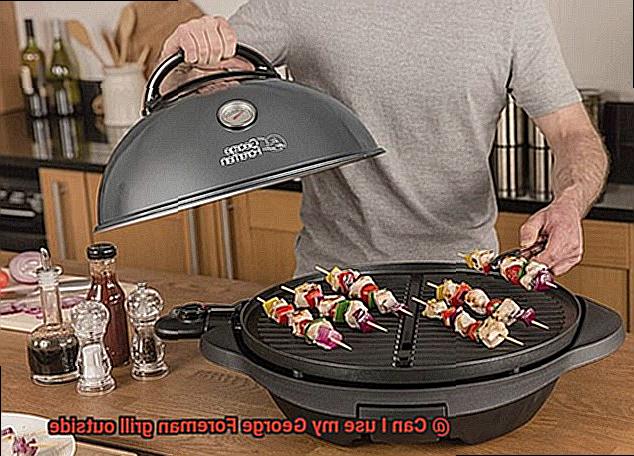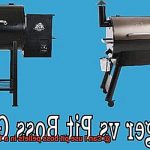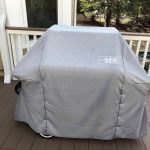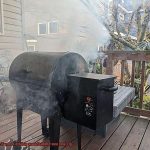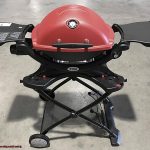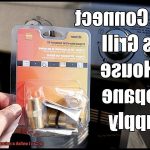Are you tired of being limited by the cookware you can use when grilling? Do you ever find yourself wondering if you can use a nonstick skillet on your grill? Well, wonder no more because we’ve got the answer for you.
Grilling has been around for centuries and remains a beloved cooking method for many. But let’s face it, sometimes our grill-specific cookware just doesn’t cut it. That’s where the question arises, “Can I use a nonstick skillet on a grill?”
The good news is that yes, you can absolutely use a nonstick skillet on your grill. However, there are some important things to keep in mind when using this type of cookware in this setting. In this post, we’ll explore the ins and outs of using nonstick skillets on a grill. We’ll cover everything from what to consider before using them, to the pros and cons of doing so, and even some best practices for optimal results.
So grab a cold drink, kick back, and let’s dive into the exciting world of nonstick skillets and grilling. With this information at your fingertips, you’ll be able to take your grilling game to new heights with ease.
Contents
What is a Nonstick Skillet?
Say goodbye to the days of scrubbing your frying pan after every use and hello to the convenience of a nonstick skillet. This type of frying pan has a special coating on the cooking surface that prevents food from sticking to it, making cooking and cleanup a breeze. The coating is typically made from polytetrafluoroethylene (PTFE), also known as Teflon.
Nonstick skillets are a popular choice among home cooks because they make cooking easier, especially for delicate foods like fish and eggs. These skillets come in various sizes and shapes, and can be made from different materials like aluminum, stainless steel, or cast iron. Some nonstick skillets are even oven-safe, allowing you to use them for baking or broiling.
However, not all nonstick coatings are created equal. It’s important to check the manufacturer’s recommendations before using a nonstick skillet on high heat. Some coatings can only handle low to medium heat, while others can withstand high temperatures up to 500°F.
While these skillets are great for stove top use, they may not be suitable for grilling. Grilling involves cooking food over an open flame or hot coals, which can cause the nonstick coating to break down and release toxic fumes. Additionally, nonstick skillets may not be able to withstand the high heat of a grill, which can cause them to warp or become damaged.
Factors to Consider Before Using a Nonstick Skillet on the Grill
Before you whip out your skillet on the grill, there are important factors to consider.
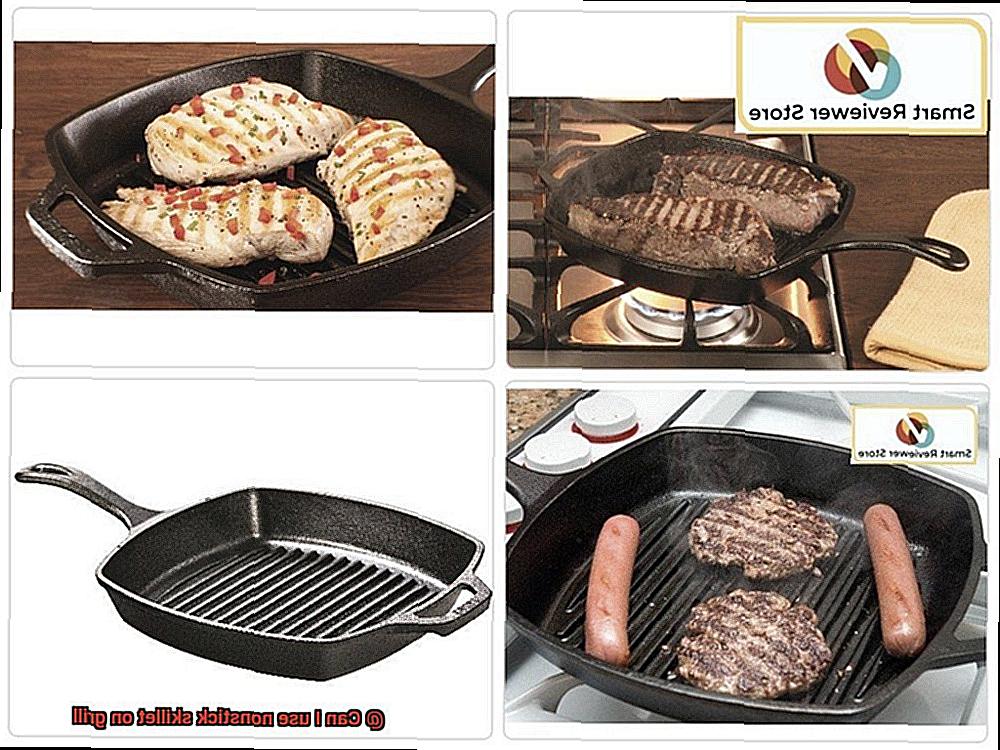
Firstly, not all nonstick skillets can handle the high heat of a grill. Some may warp or melt under intense temperatures, so it’s essential to choose a skillet made specifically for the grill. A well-made nonstick skillet is a great investment that will save you time and effort in the long run.
Equally crucial is the type of coating used on the skillet. Traditional nonstick coatings, such as Teflon, are not suitable for the grill because they release toxic fumes when exposed to high heat. Ceramic or diamond-infused coatings are designed to withstand higher temperatures without releasing harmful chemicals. These coatings are safe and won’t affect the taste of your food.
Size and shape matter too. The skillet should fit comfortably on your grill and have a flat bottom for even cooking. A deeper skillet provides more versatility in terms of the types of dishes you can prepare on the grill. You don’t want to be limited by the size of your skillet when cooking up your favorite meals.
Finally, consider what type of food you want to cook in the skillet. Nonstick skillets are perfect for delicate foods like fish and veggies but may not be suitable for heavy meats or foods that require high heat searing. In these cases, it may be better to use a cast iron or stainless steel skillet that can handle higher temperatures and provide a better sear.
Can I Use a Nonstick Skillet on a Gas Grill?
The good news is that you can use a nonstick skillet on a gas grill. However, there are some important things to keep in mind before you start grilling.
Firstly, ensure that you choose a nonstick skillet that is designed for high heat. Look for skillets labeled as oven-safe or capable of handling temperatures up to 500°F or higher. This guarantees that your skillet can endure the heat of the grill without warping or melting.
Secondly, it’s crucial to choose a skillet with metal handles that can withstand the heat of the grill. Avoid skillets with plastic handles or any other parts that may melt or warp under high heat. By doing this, you ensure that your skillet lasts for a long time and prevent any accidents.
When it comes to the type of food you will be cooking, nonstick skillets work best for delicate foods like fish and vegetables. However, they may not be the best choice for foods that require high heat and searing, such as steaks or burgers. Keep this in mind when choosing what to cook on your nonstick skillet.
Finally, proper care of your nonstick skillet is vital to ensure it lasts for a long time. Avoid using metal utensils which may scratch the nonstick coating and always hand wash your skillet with warm soapy water instead of putting it in the dishwasher.
Can I Use a Nonstick Skillet on a Charcoal or Pellet Grill?
The short answer is yes, but there are a few important things to keep in mind to ensure your safety and the best results.
Firstly, not all nonstick skillets are created equal. Some coatings are not designed to withstand high temperatures and can release harmful chemicals when exposed to heat. To avoid this, it is crucial to choose a skillet specifically designed for high-heat cooking.
Secondly, the type of skillet you use also matters. Skillets with thin bases made from lightweight materials like aluminum may warp or even melt on a grill. On the other hand, heavy-gauge skillets made from durable materials like stainless steel or cast iron are ideal for grilling.
Now that you have the right skillet, it’s time to take some precautions while cooking. Remember to use oven mitts or heat-resistant gloves when handling the skillet as the handle will get hot. Additionally, avoid using metal utensils that can scratch the nonstick coating and cause it to peel off.
While using a nonstick skillet on a grill is possible, delicate foods like fish and vegetables tend to work best as they stick more easily on other types of grilling surfaces. However, high-heat and searing dishes like steaks or burgers may not be the best choice as they require a higher temperature and can damage the nonstick coating over time.
To summarize, here are some tips for using a nonstick skillet on a charcoal or pellet grill:
- Choose a skillet specifically designed for high-heat cooking
- Use a heavy-gauge skillet made from durable materials
- Use oven mitts or heat-resistant gloves when handling the skillet
- Avoid using metal utensils that can scratch the nonstick coating
- Consider grilling delicate foods like fish and vegetables
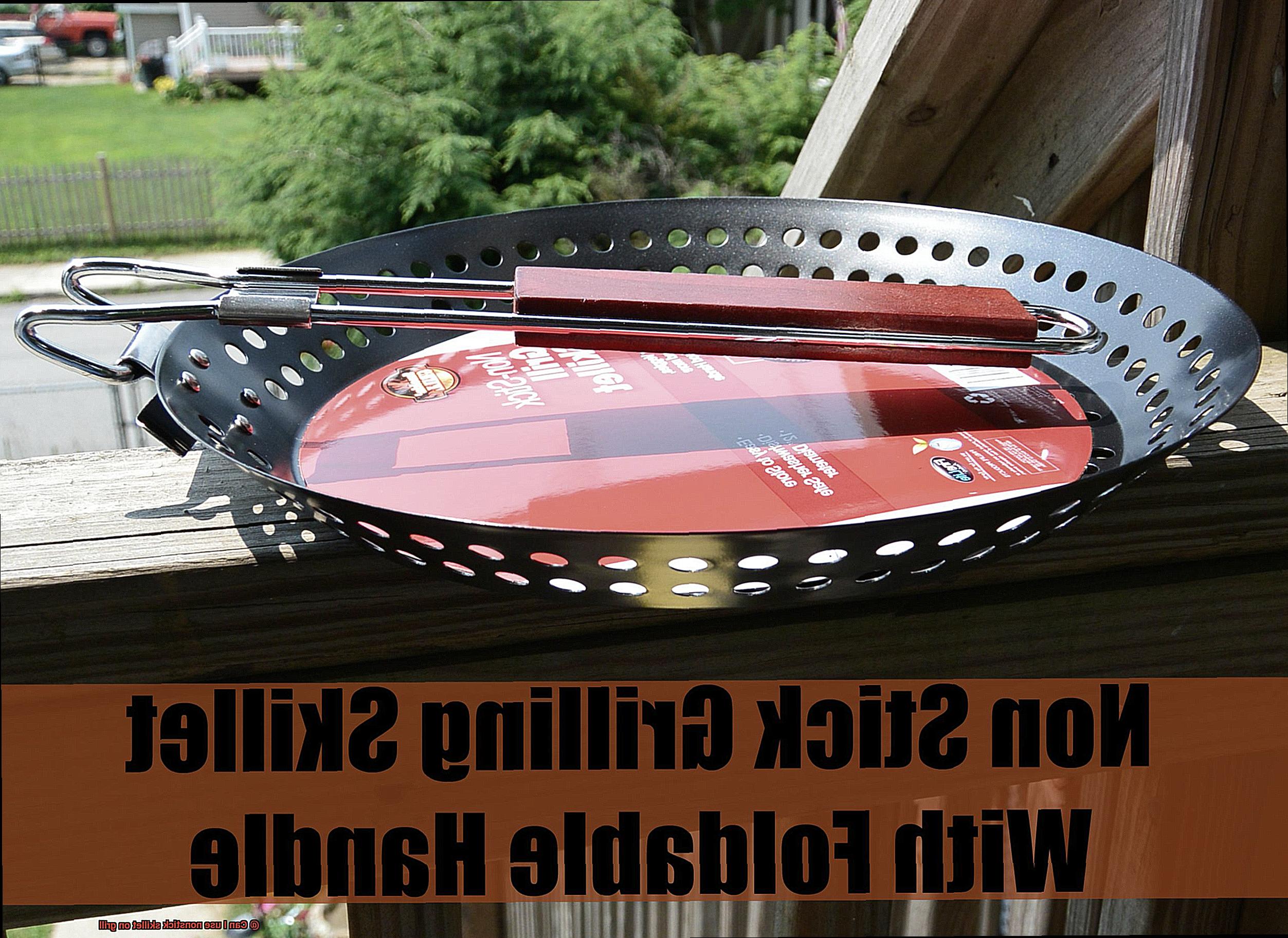
What Food Should I Avoid Cooking With a Nonstick Skillet on the Grill?
Grill masters, listen up. When it comes to using a nonstick skillet on the grill, there are certain foods that you should steer clear of. The high heat of the grill can cause the nonstick coating to break down and release toxic fumes, so it’s important to know what foods to avoid.
First and foremost, choose a nonstick skillet that is specifically designed for high-heat cooking and made from durable materials like stainless steel or cast iron. And remember to always use heat-resistant gloves and avoid metal utensils that can scratch the nonstick coating.
Now let’s get into the nitty-gritty of what foods to avoid. Anything that contains high levels of acid, such as tomatoes, citrus fruits, and vinegar-based marinades, should be off-limits. These acidic foods can react with the nonstick coating and cause it to break down, releasing harmful chemicals into your food.
In addition, stay away from foods that require high heat or searing, like steaks, burgers, and fish. The intense heat required for these types of foods can cause the nonstick coating to break down, resulting in a less effective nonstick surface and potentially harmful fumes.
And don’t forget about using metal utensils on your nonstick skillet when cooking on the grill. Scratching or scraping the surface of the skillet can cause the nonstick coating to break down and release toxic fumes.
Tips for Using a Nonstick Skillet on the Grill
Grilling is a fantastic way to cook up delicious meals, but sometimes the grates can be a bit daunting, especially when cooking delicate foods. Fortunately, a nonstick skillet can come to the rescue. By following a few tips and tricks, you can use a nonstick skillet on the grill to cook up mouthwatering dishes without worrying about sticking or damage to your skillet.
Firstly, it’s crucial to choose the right skillet for the job. Look for a skillet that is specifically designed for high-heat cooking, with a heat-resistant coating and sturdy construction. This will help ensure that your skillet stays in excellent condition through multiple uses.
Next, make sure to preheat your skillet before cooking. This step helps ensure that your food cooks evenly and doesn’t stick to the pan. Once your skillet is hot, lightly coat the surface with oil or butter to prevent sticking. However, be sure not to use too much oil as it can cause flare-ups on the grill.
It’s also essential to avoid overcrowding the pan while using a nonstick skillet on the grill. Overcrowding can cause the temperature to drop and result in uneven cooking. If necessary, cook in batches or opt for a larger skillet if you need to cook more food at once.
When grilling with a nonstick skillet, using a lid can be helpful in trapping heat and steam, ensuring that your food cooks evenly and doesn’t dry out. However, it’s essential to use a heat-resistant lid that fits securely on your skillet.
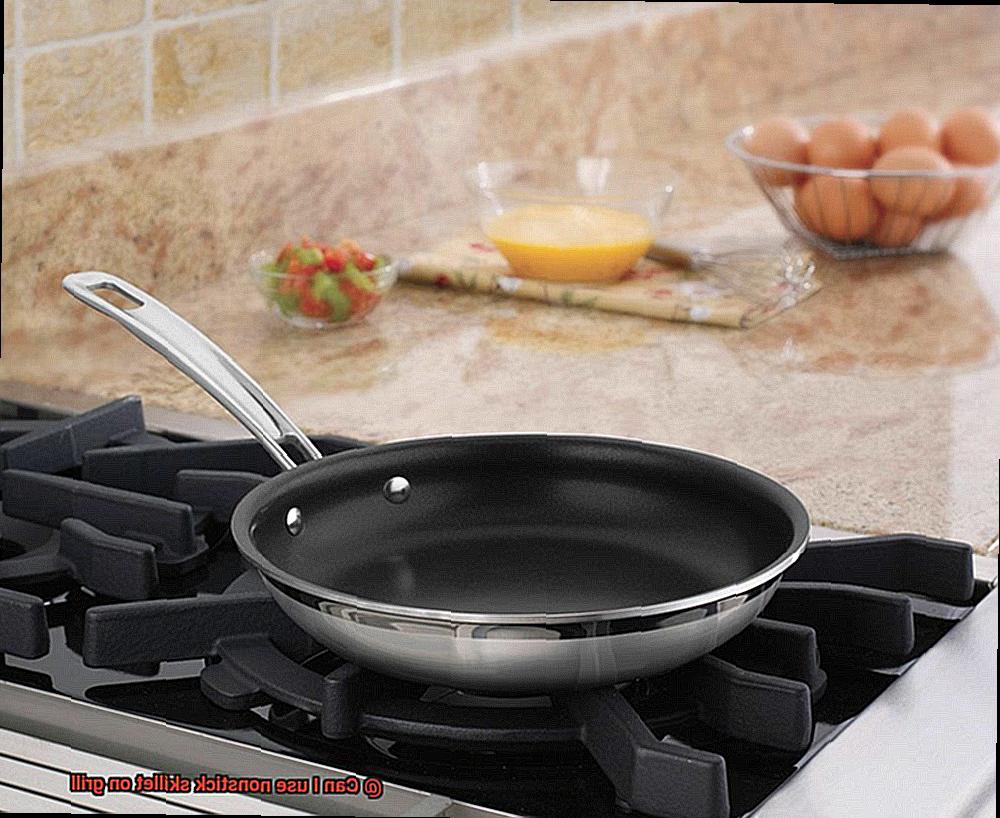
Lastly, after finishing cooking with your nonstick skillet on the grill, allow it to cool completely before washing it. Use warm water and gentle dish soap to clean the skillet and avoid using abrasive sponges or scrubbers that can damage the nonstick coating.
How to Clean and Maintain Your Nonstick Skillet
Grilling is a fantastic way to cook up your favorite dishes, but if you’re using a nonstick skillet on the grill, it’s essential to know how to clean and maintain it properly. While nonstick skillets are great for cooking on the stove, they may not be the best option for grilling due to their sensitivity to high heat. However, if you do choose to use a nonstick skillet on the grill, there are some steps you can take to keep it in good condition.
Use the Right Utensils:
One of the most important things to remember when using a nonstick skillet on the grill is to avoid using metal utensils. Metal utensils can scratch the surface of the skillet, causing damage to the nonstick coating. Instead, use silicone, nylon, or wooden utensils that won’t scratch the surface.
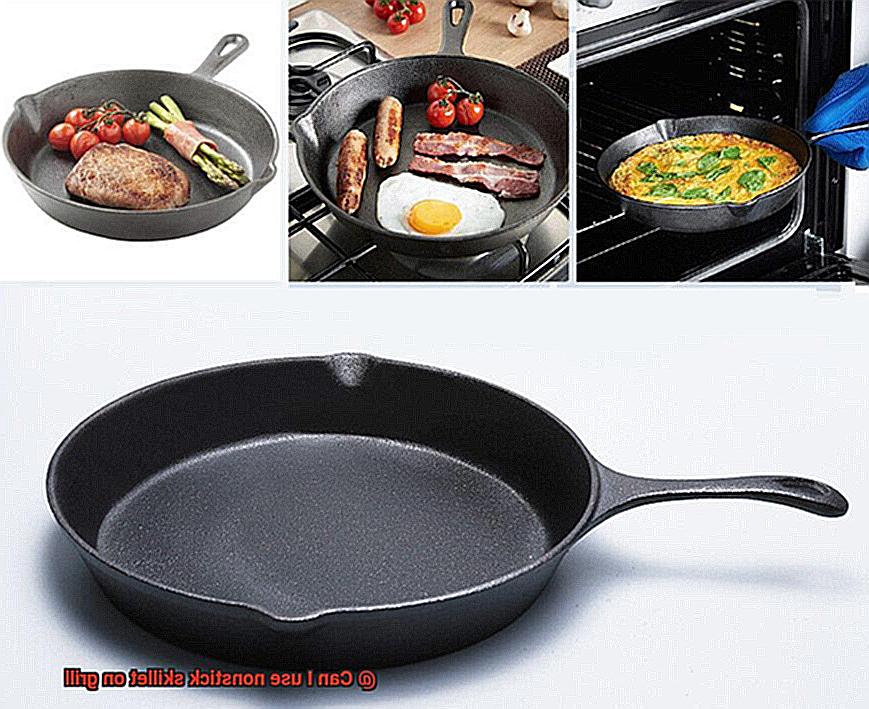
Avoid High Heat:
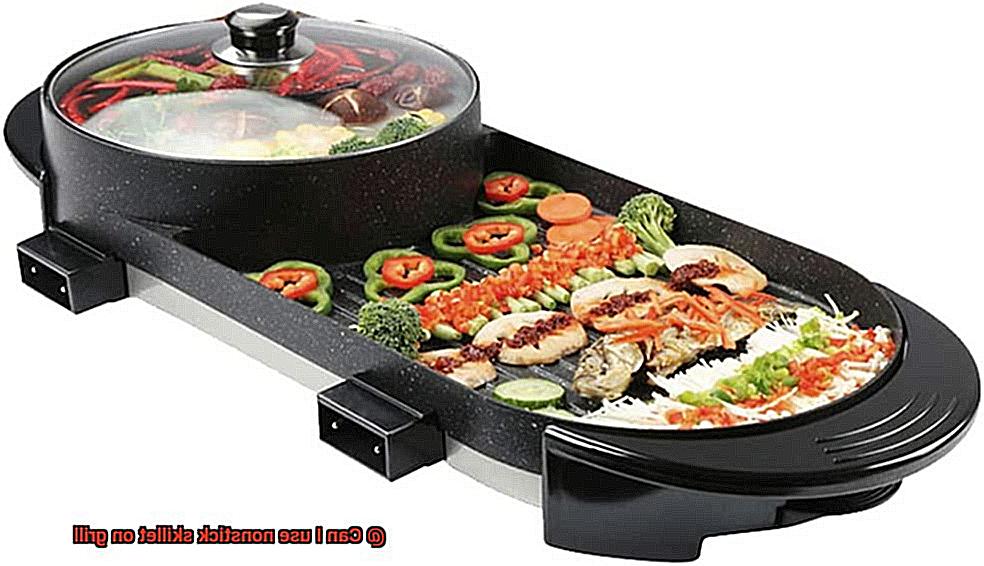
High heat can cause the nonstick coating to break down over time, making it less effective at preventing food from sticking. Stick to medium heat settings when cooking with your nonstick skillet on the grill and monitor the temperature closely to avoid overheating. You can also use a protective mat or foil under your skillet to prevent direct contact with the grill’s surface.
Clean After Each Use:
Cleaning your nonstick skillet after each use is crucial for maintaining its longevity. Avoid using harsh abrasives or steel wool when cleaning your skillet, as they can scratch and damage the nonstick coating. Instead, use a gentle sponge or cloth with mild dish soap and warm water to clean the skillet thoroughly. If there are stubborn stains or food particles stuck on the skillet, fill it with water and a few drops of dish soap and let it soak for a few hours before gently scrubbing with a soft sponge.
Store Properly:
Properly storing your nonstick skillet is important to prevent any damage or warping. Avoid stacking heavy objects on top of it or storing it in a tight space where it may become warped. Instead, hang it or store it in a dry location where it can air-dry completely before putting it away.
Know When to Replace:
If you notice food sticking to your nonstick skillet even after cleaning it, it may be time to replace it. Nonstick skillets have a limited lifespan, and if the coating becomes damaged or worn down over time, it won’t be as effective at preventing food from sticking. Consider investing in a cast iron skillet or other grill-safe cookware to ensure the best results.
WNBWpKCm0Zc” >
Also Read: Can Galvanized Sheet Metal be Used on a Cooking Grill?
Conclusion
In conclusion, the answer to whether you can use a nonstick skillet on a grill is a resounding yes. However, it’s crucial to pick the right skillet and take necessary precautions to ensure safety and optimal results. When selecting a nonstick skillet for grilling, consider factors such as coating type, size and shape, and the food you want to cook. Traditional nonstick coatings like Teflon are not suitable for high-heat cooking and can release harmful chemicals when exposed to heat. Instead, opt for ceramic or diamond-infused coatings that are safe and designed to withstand higher temperatures without affecting your food’s taste.
Using a nonstick skillet on a gas or charcoal grill requires using oven mitts or heat-resistant gloves when handling the skillet, avoiding overcrowding the pan, and cleaning/maintaining your skillet properly after each use. By following these tips and tricks, you’ll be able to expand your cooking options and elevate your grilling game with ease.
Proper care and maintenance of your nonstick skillet are crucial for ensuring its longevity and effectiveness in preventing food from sticking. With these guidelines in mind, you can enjoy delicious grilled meals without worrying about limited cookware options.

